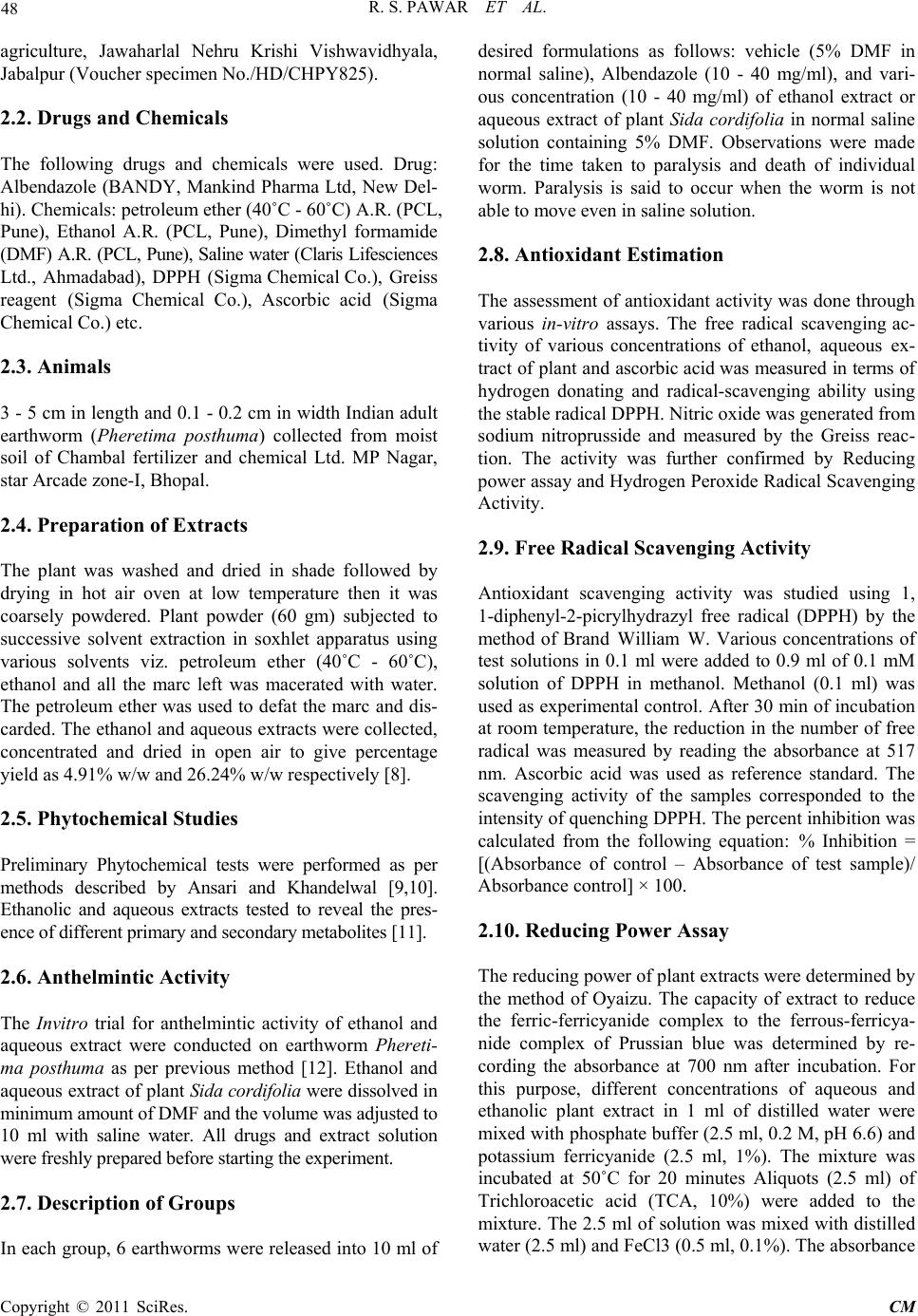
R. S. PAWAR ET AL.
Copyright © 2011 SciRes. CM
agriculture, Jawaharlal Nehru Krishi Vishwavidhyala,
Jabalpur (Voucher specimen No./HD/CHPY825).
2.2. Drugs and Chemicals
The following drugs and chemicals were used. Drug:
Albendazole (BANDY, Mankind Pharma Ltd, New Del-
hi). Chemicals: petroleum ether (40˚C - 60˚C) A.R. (PCL,
Pune), Ethanol A.R. (PCL, Pune), Dimethyl formamide
(DMF) A.R. (PCL, Pune), Saline water (Claris Lifesciences
Ltd., Ahmadabad), DPPH (Sigma Chemical Co.), Greiss
reagent (Sigma Chemical Co.), Ascorbic acid (Sigma
Chemical Co.) etc.
2.3. Animals
3 - 5 cm in length and 0.1 - 0. 2 cm in width Indian adult
earthworm (Pheretima posthuma) collected from moist
soil of Chambal fertilizer and chemical Ltd. MP Nagar,
star Arcade zone-I, Bhopal.
2.4. Preparation of Extracts
The plant was washed and dried in shade followed by
drying in hot air oven at low temperature then it was
coarsely powdered. Plant powder (60 gm) subjected to
successive solvent extraction in soxhlet apparatus using
various solvents viz. petroleum ether (40˚C - 60˚C),
ethanol and all the marc left was macerated with water.
The petroleum ether was used to defat the marc and dis-
carded. The ethanol and aqueous extracts were collected,
concentrated and dried in open air to give percentage
yield as 4.91% w/w and 26.24% w/w respectively [8].
2.5. Phytochemical Studies
Preliminary Phytochemical tests were performed as per
methods described by Ansari and Khandelwal [9,10].
Ethanolic and aqueous extracts tested to reveal the pres-
ence of diffe rent prim ary and sec ondary me taboli tes [ 11].
2.6. Anthelmintic Activity
The Invitro trial for anthelmintic activity of ethanol and
aqueous extract were conducted on earthworm Phereti-
ma posthuma as per previous method [12]. Ethanol and
aqueous extract of plant Sida cordifolia were dissolved in
minimum amount of DMF and the volume was adjusted to
10 ml with saline water. All drugs and extract solution
were freshly prepared before starting the experiment.
2.7. Description of Groups
In each group, 6 earthwo rms were released into 10 ml o f
desired formulations as follows: vehicle (5% DMF in
normal saline), Albendazole (10 - 40 mg/ml), and vari-
ous concentration (10 - 40 mg/ml) of ethanol extract or
aqueous extract of plant Sida cordifolia in normal saline
solution containing 5% DMF. Observations were made
for the time taken to paralysis and death of individual
worm. Paralysis is said to occur when the worm is not
able to move even in saline solution.
2.8. Antioxidant Estimation
The assessment of antioxidant activity was done through
various in-vitro assays. The free radical scavenging ac-
tivity of various concentrations of ethanol, aqueous ex-
tract of plant and ascorbic acid was measured in ter ms of
hydrogen donating and radical-scavenging ability using
the stable radical DPPH. Nitric oxide was generated from
sodium nitroprusside and measured by the Greiss reac-
tion. The activity was further confirmed by Reducing
power assay and Hydrogen Peroxide Radical Scavenging
Activity.
2.9. Free Radical Scavenging Activity
Antioxidant scavenging activity was studied using 1,
1-diphenyl-2-picrylhydrazyl free radical (DPPH) by the
method of Brand William W. Various concentrations of
test solutions in 0.1 ml were added to 0.9 ml of 0.1 mM
solution of DPPH in methanol. Methanol (0.1 ml) was
used as experimental control. After 30 min of incubation
at room temperature, the reduction in the number of free
radical was measured by reading the absorbance at 517
nm. Ascorbic acid was used as reference standard. The
scavenging activity of the samples corresponded to the
intensity of quenching DPPH. The percent inhibition was
calculated from the following equation: % Inhibition =
[(Absorbance of control – Absorbance of test sample)/
Absorbance control] × 100.
2.10. Reducing Power Assay
The reducing power of plant extracts were determined by
the method of Oyaizu. The capacity of extract to reduce
the ferric-ferricyanide complex to the ferrous-ferricya-
nide complex of Prussian blue was determined by re-
cording the absorbance at 700 nm after incubation. For
this purpose, different concentrations of aqueous and
ethanolic plant extract in 1 ml of distilled water were
mixed with pho sphate buffer (2.5 ml, 0. 2 M, pH 6.6) and
potassium ferricyanide (2.5 ml, 1%). The mixture was
incubated at 50˚C for 20 minutes Aliquots (2.5 ml) of
Trichloroacetic acid (TCA, 10%) were added to the
mixture. The 2.5 ml of solution was mixed with distilled
water (2.5 ml) and FeCl3 (0.5 ml, 0.1%). The absorbance